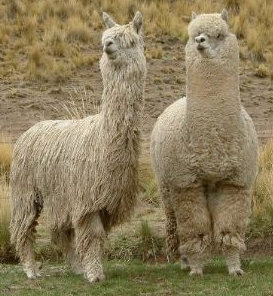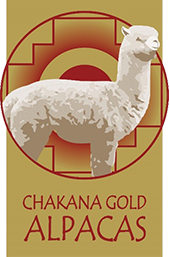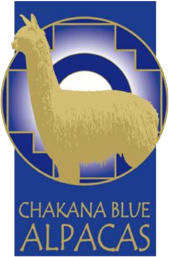GENERAL INFORMATION
Alpacas make great companions and pets and can produce exquisite luxury fleece.
They are suitable for both broad acreage and smaller scale hobby farming.
As herd guards for other livestock their astounding maternal instincts are like none other.
TWO DIFFERENT BREEDS
Alpacas belong to the Camelid family which consists of;
Camels (Three types. 1- Wild Bactrian Camel. 2- Dromedary Camel -single hump. 3- Bactrian camel -two humps)
Guanacos Vicuna Llamas Alpacas (Two types. 1- Huacayas. 2- Suris)
A Suri and a Huacaya Alpaca pictured in full fleece.
**Pronounced Sue-ree and Whack-higher

ALPACA FIBRE
Both Suri and Huacaya Alpaca fibre is versatile, warm, strong and water resistant.
It comes in 22 beautiful natural colours.
Its low allergenic and fine micron fibre is soft enough to wear against your skin with no prickle.
No other fibre animal produces so many colours. Alpaca is also the only fibre animal that can produce a true black fibre. The lustre shines through in alpaca when processed in its true natural colour. It also accepts dyes without trouble.
Alpaca does not contain lanolin, making it possible to process without the harsh scouring that sheep wool requires. It is also the reason alpaca can have 87-95% clean fibre yield whereas sheep tend to have a 43-76%clean fibre yield.
Both Huacayas and Suris should be shorn every year. With the exception of very young or old or perhaps unwell. Certain high quality Suris may also be left in fleece for competition.
ALPACA BREED STANDARD
(Last updated December 2020)
HUACAYA AND SURI CONFORMATION
The alpaca is a tall, graceful animal with a smoothly blended body and upright stance. It carries its head high. It is strong boned and vigorous. It has good conformation with all its parts in correct proportion and when true to type has the characteristics described in this standard.
Head: The head has a strong appearance and is not coarse. It is neatly formed, of medium length and with a square muzzle. The eyes are oval in shape, alert and set well apart. They protrude slightly from their sockets, giving the appearance of being large and round. They may be blue, brown or black. The nose has two well-defined nostrils. The upper lip is divided and mobile. The ears are of medium length, covered with short soft hair, erect and bayonet-shaped, pointing forward in the alert stance. Suri ears can be up to 2cms longer than huacaya ears. The jaws fit together well, with the lower incisors meeting the upper dental pad.
Faults
- Muffled face (fibre or hair impeding the animal’s vision – particularly after first shearing)
- Wry face
- Head very narrow
- Face hard and open
- Roman nose
- Lower jaw undershot or overshot
Neck: The neck is long and slender and continues directly from the line of the backbone, blending smoothly into the shoulder.
Faults
- Length of neck disproportionate to body size (too long or too short)
- Neck bent or U-neck
Forequarters: The chest is broad and deep, well sprung in the fore-rib. The wither is relatively wide where the shoulders meet, well fleshed and set well into the shoulders forming a straight line with the back.
Faults
- Narrow chest
- Loose shoulder blades
- In or out at the elbows
- Prominent wither
Body: The body is deep through the girth, with well-sprung ribs. The back is strong, and the top-line is slightly convex. The loins are broad, strong and flat, with the back barrel large and deep.
Faults
- Roach back
- Sway Back
- Over-long straight back
Hindquarters: The rump is broad with a slightly convex top line. There is good space between the pin bones. The tail is straight, covered with quality fibre, set slightly lower than in other livestock and should cover the genitalia. The thighs are strong and well-muscled. The height of the pin-bones equals that of the shoulders.
Faults
- Narrow hindquarters
- Bent or kinked tail that cannot be manually straightened or where there are no signs of a break/calcification
- Steeply sloping rump
Legs: The forelegs are strong and straight. The hind legs are straight and parallel when viewed from behind. The pasterns are firm and upright. The feet are neat and well-formed and bear two forward pointing toes each carrying a long strong toenail. The sole of the foot is covered with a callused membrane.
Faults
- Weak pasterns
- Obvious carpal
- Cow hocks
- Sickle hocks
Udder: The udder should show good capacity, with four working teats.
Faults
- Less or more than four teats
- Inverted teat(s) (irrespective of number and position)
Testicles: The scrotum is well attached, relatively small and carries two even sized testes.
Faults
- Testes of uneven size
- Testes too small (relative to age)
Height and Weight: A mature animal measures from approximately 90 cm at the wither and weighs from approximately 60 kg upwards.
Faults
- Oversized – particularly if llama-like characteristics present
Movement: Alpacas should exhibit an even stride length with two distinct tracks, the hind feet following the front ones.
Faults
- Uneven stride length
- Paddling on the front feet
Disqualifying Faults:
- Polydactylism (more than two toes on each foot)
- Syndactylism (fusion of the two toes of the same foot)
- Fused ears (short stubby ears or fused at the tips)
- Banana shaped ears
- Tail absent or abnormally short or bent
- Fewer than two testes
- Jaw not properly aligned
- Jaw excessively overshot
- Jaw excessively undershot
POINTS OF THE ALPACA

ALPACA BONE STRUCTURE


